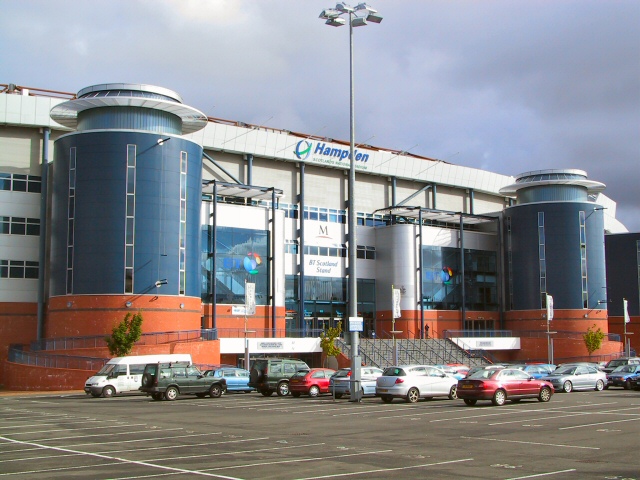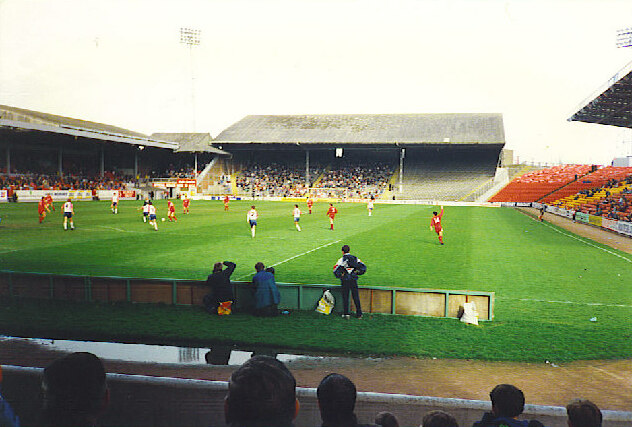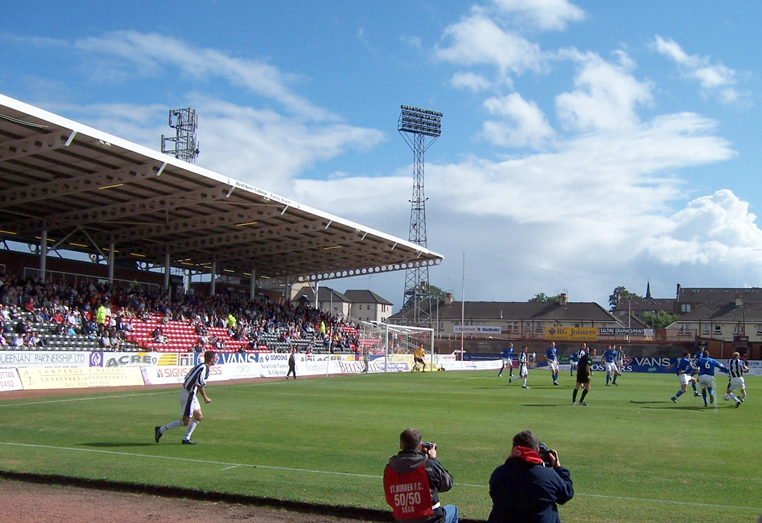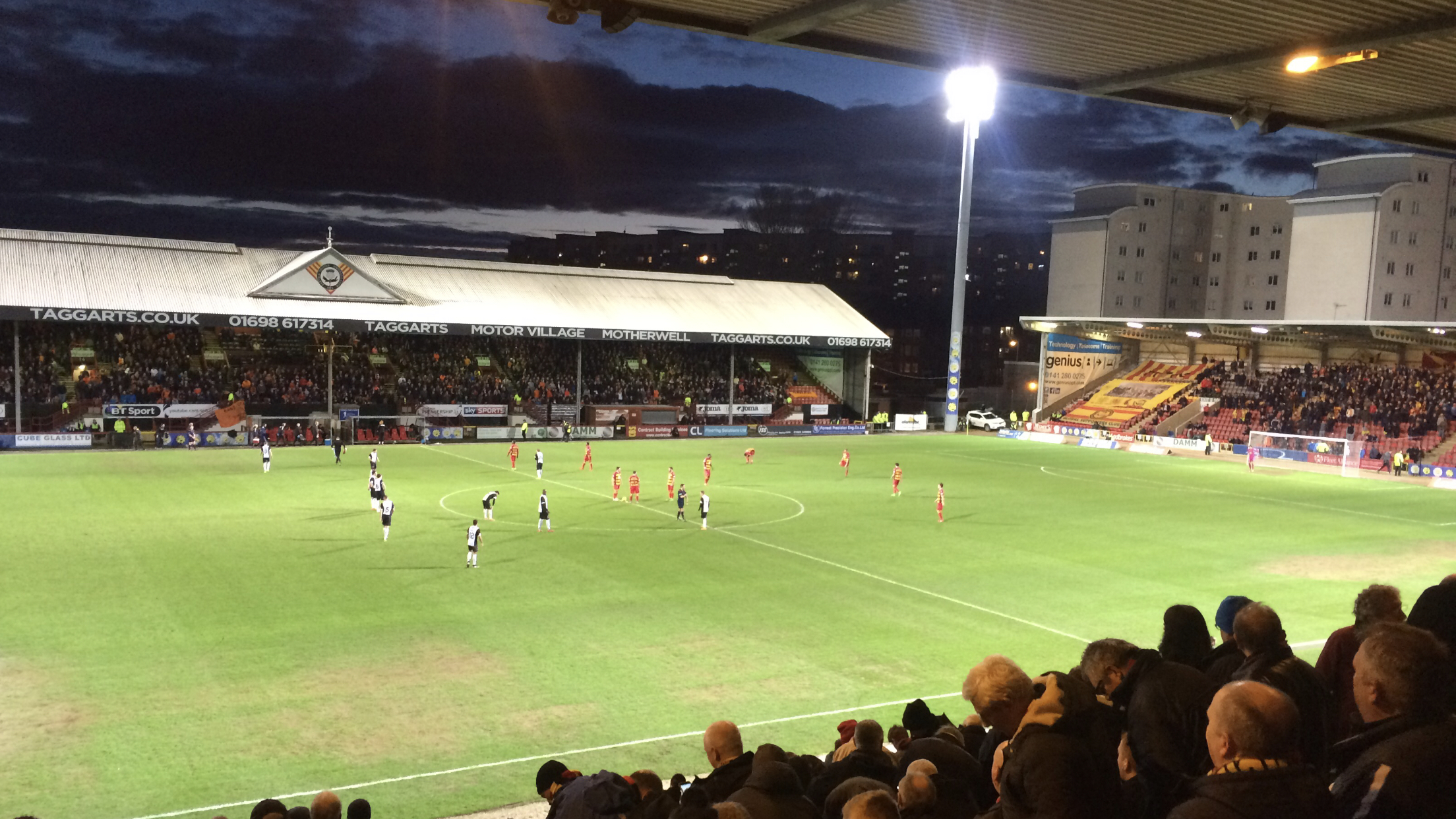|
Scottish Football Attendance Records
This article lists Scottish football attendance records under the categories listed below. The highest ever attendance for a UEFA competition match was in the 1969–70 European Cup semi-final at Hampden Park, Scotland's national stadium. A record 136,505 people attended the match between Celtic and Leeds United. The attendance of 149,415 for the Scotland vs. England international match of 1937 at Hampden Park is also a European record. The attendance of 147,365 for the 1937 Scottish Cup Final between Celtic and Aberdeen at Hampden Park is a European record for a club match. Rangers' record attendance of 118,567 at Ibrox is a British record for a league match. By club Current SPFL member clubs This is a list of all 42 Scottish Professional Football League clubs' record match attendances at their home ground. The vast majority of these records were achieved before the advent of all-seater stadia. The cost of building all-seater grounds, and a general decline in attendances, mean ... [...More Info...] [...Related Items...] OR: [Wikipedia] [Google] [Baidu] |
Hampden Park
Hampden Park (Scottish Gaelic: ''Pàirc Hampden''), often referred to as Hampden, is a football stadium in the Mount Florida area of Glasgow, Scotland. The -capacity venue serves as the national stadium of football in Scotland. It is the normal home venue of the Scotland national football team and was the home of club side Queen's Park for over a century. Hampden regularly hosts the latter stages of the Scottish Cup and Scottish League Cup competitions and has also been used for music concerts and other sporting events, such as when it was reconfigured as an athletics stadium for the 2014 Commonwealth Games. There were two 19th-century stadia called Hampden Park, built on different sites. A stadium on the present site was first opened on 31 October 1903. Hampden was the biggest stadium in the world when it was opened, with a capacity in excess of 100,000. This was increased further between 1927 and 1937, reaching a peak of 150,000. The record attendance of 149,415, for a S ... [...More Info...] [...Related Items...] OR: [Wikipedia] [Google] [Baidu] |
Hibernian F
Hibernian may refer to: * Of Hibernia, Latin name for Ireland; hence ** Irish (other) Hibernian, Hibernians or The Hibernian may refer to: Sports clubs * Hibernian F.C., a Scottish football club, founded 1875 * Hibernian W.F.C., a Scottish women's football club, founded 1999, affiliated with Hibernian F.C. * Hibernians F.C., a Maltese football club, founded 1922 * Cambuslang Hibernian F.C., a Scottish football club, active 1884–1908 * Cork Hibernians F.C., an Irish soccer club, active 1957–1977 * Dundee Hibernian F.C., a Scottish football club, founded 1909 (renamed Dundee United in 1923) * Duntocher Hibernian F.C., a Scottish football club, active 1894–1980 * Maryhill Hibernians F.C., a Scottish football club, active 1923–1967 (renamed Maryhill Harp in 1939) * Navan Hibernians GAC, an Irish hurling club active in 1902 * Philadelphia Hibernian, an American soccer club, active 1909–1921 * Seattle Hibernian, an American soccer club, successively named Seat ... [...More Info...] [...Related Items...] OR: [Wikipedia] [Google] [Baidu] |
Motherwell F
Motherwell ( sco, Mitherwall, gd, Tobar na Màthar) is a town and former burgh in North Lanarkshire, Scotland, United Kingdom, south east of Glasgow. It has a population of around 32,120. Historically in the parish of Dalziel and part of Lanarkshire, Motherwell is the headquarters for North Lanarkshire Council. Geographically the River Clyde separates Motherwell from Hamilton to the west whereas the South Calder Water separates Motherwell from Carfin to the north-east and New Stevenston and Bellshill towards the north. Motherwell is also geographically attached to Wishaw and the two towns form a large urban area in North Lanarkshire, with both towns having similar populations and strong community ties. History A Roman road through central Scotland ran along Motherwell's side of the River Clyde, crossing the South Calder Water near Bothwellhaugh. At this crossing a fort and bath house were erected, but the Roman presence in Scotland did not last much later than this. Mothe ... [...More Info...] [...Related Items...] OR: [Wikipedia] [Google] [Baidu] |
Rugby Park
Rugby Park, also known as The BBSP Stadium Rugby Park for sponsorship reasons, is a football stadium situated in the Scottish town of Kilmarnock. It was first used in 1899 and is the home of Kilmarnock F.C. Rugby Park has also been used for concerts, with Elton John playing to 15,000 in a first for the venue. In 2002, the club constructed the Park Hotel, a 4-star hotel complex next to the ground. The stadium underwent a major redevelopment in 1994–1995, becoming an all-seater stadium with a capacity of . During 1994–95 season the stadium capacity was significantly reduced as a result of the construction of three new stands within the groups which were the Moffat Stand, the Chadwick Stand and the East Stand. The completion of these three stands reduced the capacity of the stadium to 18,128. The renovated stadium opened on 6 August 1995, with a friendly match against Blackburn Rovers F.C. Rugby Park has since undergone recent developments regarding further renovations, with a ... [...More Info...] [...Related Items...] OR: [Wikipedia] [Google] [Baidu] |
Kilmarnock F
Kilmarnock (, sco, Kilmaurnock; gd, Cill Mheàrnaig (IPA: ʰʲɪʎˈveaːɾnəkʲ, "Marnock's church") is a large town and former burgh in East Ayrshire, Scotland and is the administrative centre of East Ayrshire Council. With a population of 46,770, Kilmarnock is the 14th most populated settlement in Scotland and the largest town in Ayrshire. The town is continuous to nearby neighbouring villages Crookedholm and Hurlford to the east, and Kilmaurs to the west of the town. It includes former villages subsumed by the expansion of the town such as Bonnyton and new purpose built suburbs such as New Farm Loch. The town and the surrounding Greater Kilmarnock area is home to 32 listed buildings and structures designated by Historic Environment Scotland. The River Irvine runs through the eastern section of Kilmarnock, and the Kilmarnock Water passes through it, giving rise to the name 'Bank Street'. The first collection of work by Scottish poet Robert Burns, ''Poems, Chiefly in ... [...More Info...] [...Related Items...] OR: [Wikipedia] [Google] [Baidu] |
Dens Park
Dens Park, officially known as Kilmac Stadium for sponsorship reasons, is a football stadium in Dundee, Scotland, which is the home of club Dundee F.C. and has a capacity of . Tannadice Park, the home of rivals Dundee United, is just 200 yards (183 metres) away. History Dundee moved to "Dens" from their first stadium at Carolina Port in 1899. Following Dundee's successful league campaign during the 1998–99 season, Dens park had to be redeveloped to adhere to the new Scottish Premier League seat-capacity guidelines. Dundee were therefore required to redevelop the East and West terraces. Barr Stadium Construction were charged with the task of removing the existing concrete terraces and the construction of two 3,000-seat stands. The stands were built in a record time of 82 days for the start of the 1999–00 season. The two near-identical single-tier Bobby Cox and Bob Shankly Stands sit at either end of the ground. The former usually houses home supporters while the latter house ... [...More Info...] [...Related Items...] OR: [Wikipedia] [Google] [Baidu] |
Dundee F
Dundee (; sco, Dundee; gd, Dùn Dè or ) is Scotland's List of towns and cities in Scotland by population, fourth-largest city and the List of urban areas in the United Kingdom, 51st-most-populous built-up area in the United Kingdom. The mid-year population estimate for 2016 was , giving Dundee a population density of 2,478/km2 or 6,420/sq mi, the List of Scottish council areas by population density, second-highest in Scotland. It lies within the eastern central Lowlands on the north bank of the Firth of Tay, which feeds into the North Sea. Under the name of Dundee City, it forms one of the 32 Council areas of Scotland, council areas used for local government in Scotland. Within the boundaries of the Shires of Scotland, historic county of Angus, Scotland, Angus, the city developed into a burgh in the late 12th century and established itself as an important east coast trading port. Rapid expansion was brought on by the Industrial Revolution, particularly in the 19th century w ... [...More Info...] [...Related Items...] OR: [Wikipedia] [Google] [Baidu] |
Pittodrie Stadium
Pittodrie Stadium, commonly referred to as Pittodrie, is an all-seater stadium in Aberdeen, Scotland. Used primarily for football, it has been the home ground of the Scottish Professional Football League (SPFL) club Aberdeen F.C. since they were formed in 1903. Prior to then, the ground hosted the original Aberdeen F.C. from 1899 until the merger that created the present club. With a seating capacity of ; Pittodrie is the fourth largest stadium in the SPFL and the largest stadium in Scotland outside the Central Belt. Pittodrie has been the location of a number of firsts in the field of stadium design, including the invention of the dugout, and in 1978 became one of the first all-seater stadia in the United Kingdom. , Pittodrie has hosted fifteen matches involving the Scotland national team. The ground has also staged rugby union, with four Scotland international fixtures being held there including a match against the Barbarians. In club football, Inverness Caledonian Thistl ... [...More Info...] [...Related Items...] OR: [Wikipedia] [Google] [Baidu] |
Love Street (stadium)
St Mirren Park, more commonly known as Love Street, was a football stadium located on Love Street in Paisley, Scotland. At one time the stadium was capable of accommodating almost 50,000 spectators, however in its final years it had an all-seated capacity of 10,800. Until its closure in 2009, it was the home ground of St Mirren F.C. The football grounds on Love Street were registered as Fullerton Park for St Mirren's first season there as they were originally rented from a Mr Fullerton. The ground's record attendance was 47,438 for a match against Celtic in 1949. St Mirren completed construction of their new St Mirren Park in December 2008. St Mirren played their last game at Love Street, against Motherwell, on 3 January 2009. Early years at Love Street When St Mirren began to play on Love Street in the mid-1890s football clubs were still very much in their infancy and moved from ground to ground renting from local landowners. The best deal available was commonly a ten-year ... [...More Info...] [...Related Items...] OR: [Wikipedia] [Google] [Baidu] |
St Mirren F
ST, St, or St. may refer to: Arts and entertainment * Stanza, in poetry * Suicidal Tendencies, an American heavy metal/hardcore punk band * Star Trek, a science-fiction media franchise * Summa Theologica, a compendium of Catholic philosophy and theology by St. Thomas Aquinas * St or St., abbreviation of "State", especially in the name of a college or university Businesses and organizations Transportation * Germania (airline) (IATA airline designator ST) * Maharashtra State Road Transport Corporation, abbreviated as State Transport * Sound Transit, Central Puget Sound Regional Transit Authority, Washington state, US * Springfield Terminal Railway (Vermont) (railroad reporting mark ST) * Suffolk County Transit, or Suffolk Transit, the bus system serving Suffolk County, New York Other businesses and organizations * Statstjänstemannaförbundet, or Swedish Union of Civil Servants, a trade union * The Secret Team, an alleged covert alliance between the CIA and American indus ... [...More Info...] [...Related Items...] OR: [Wikipedia] [Google] [Baidu] |
Firhill Stadium
Firhill Stadium is a football and former rugby union, rugby league and greyhound racing stadium located in the Maryhill area of Glasgow, Scotland which has been the home of Partick Thistle since 1909. The stadium is commonly referred to as simply Firhill, although between September 2017 and September 2020 it was also known as The Energy Check Stadium at Firhill for sponsorship reasons. Past ground-sharing agreements have seen Firhill act as a temporary home for three other football clubs: Clyde, Hamilton Academical and Queen’s Park. It was also a venue for the 2000 Rugby League World Cup and the Glasgow Warriors rugby union team between 2007 and 2012. , the all-seated capacity of Firhill is . History Partick Thistle played at various sites between 1876 and 1891, including Kelvingrove, Jordanvale Park and Muir Park. The club settled at Meadowside, beside the River Clyde, in 1891. They were forced out of this site in 1908, however, to make way for a shipyard. The club ... [...More Info...] [...Related Items...] OR: [Wikipedia] [Google] [Baidu] |
Partick Thistle F
Partick ( sco, Pairtick, Scottish Gaelic: ''Partaig'') is an area of Glasgow on the north bank of the River Clyde, just across from Govan. To the west lies Whiteinch, to the east Yorkhill and Kelvingrove Park (across the River Kelvin), and to the north Broomhill, Hyndland, Dowanhill, Hillhead, areas which form part of the West End of Glasgow. Partick was a Police burgh from 1852 until 1912 when it was incorporated into the city.Second City of The Empire: 1830s to 1914 from theglasgowstory.com. Retrieved 22 December 2011. Partick is the area of the city most connected with the , and several Gaelic agencies, such as the Gaelic Books Council ( |










.jpg)